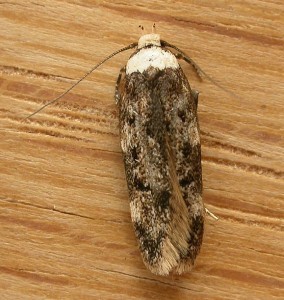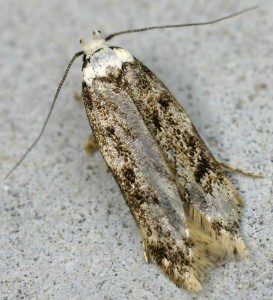Facts About White-Shouldered House Moths
Occurrence: While white-shouldered house moths were once a common problem in US homes and businesses, they are now only found occasionally indoors.
Diet: These moths are omnivorous and can feed on materials that other moths do not consume, such as straw from thatched roofs and fungi on trees. It’s important to note that it’s the larvae of the white-shouldered house moths that are responsible for eating these materials, making them the actual pests.
Controlling White-Shouldered House Moths
To combat white-shouldered house moths, you should focus on two main actions:
- Removing existing larvae and eggs through thorough cleaning.
- Preventing future infestations by using moth repellents and properly storing textiles and food products.
Steps to Control Moths:
-
Cleaning: Perform thorough vacuuming and dry cleaning (avoid using water!) of all carpets, closets, and drawers in the home. This applies to places where clothing and food are stored, such as wardrobes and kitchen cabinets.
-
Textiles: Stored or unused textiles should be shaken out or beaten and regularly inspected for moths. Store textiles in tightly sealed plastic bags.
-
Food Products: All food should be stored in airtight containers.
-
Moth Repellents: Use moth sachets and non-chemical moth traps in closets and drawers where textiles are stored. Do not use chemical repellents near food storage areas. You can also spray clothing and other textiles with anti-moth treatments. Recommended products include clothes moth traps, mediterranean flour moth traps, and moth pouches for both prevention and control.
Remember, never use water when cleaning areas where moths tend to reproduce. Instead, you can wipe surfaces with a cloth dampened with regular vinegar after vacuuming.
White-Shouldered House Moth Diet
Most moth species feed on a relatively limited range of foods, but the white-shouldered house moth is nearly omnivorous, feeding on both organic and plant-based materials.
In the past, white-shouldered house moth larvae thrived in old wallpapers, where they fed on the flour-based adhesive used to hang the wallpaper. This is rare today due to the use of different adhesive materials.
Today, white-shouldered house moths often come from bird nests near homes. They thrive in nests, feeding on feathers, down, leftover food, and other debris left by the birds.
The white-shouldered house moth's diet includes:
[/grid_col]
- Wool
- Feathers
- Down
- Fur
- Silk
- Hair
- Leather
- Carpets
- Upholstery
- Textiles
- Dried plant waste
- Animal carcasses
- Dead insects
- Rotting wood
- Fungi on trees
- Straw roofs
- Pet food
- Food scraps
- Moldy food
- Corks from wine bottles
- Dried fruit
- Grains
- Bran
- Grits
- Flour
- Seeds
- Potatoes
- Peas
- Beans
- Corn
[/grid_section]
Although white-shouldered house moths rarely attack textiles, it's always advisable to inspect all fabrics in the home if moths are detected.
Description of the White-Shouldered House Moth
Adult white-shouldered house moths have white shoulders (the upper part of the wings) and white heads. The rest of the wings are light brown or grayish-brown with dark spots.
Adult moths measure 6–11 mm in length with a wingspan of 15–21 mm. Male moths are smaller than females. Like other food moths, white-shouldered house moths are attracted to light.
The larvae are cream-colored with dark heads and can grow up to 12 mm long. white-shouldered house moth larvae are quite similar in appearance to grain moth larvae.
Life Cycle
The life cycle of the white-shouldered house moth follows these stages:
-
Egg Stage: The female moth lays her eggs in cracks, crevices, and holes, usually in warm and humid environments. She lays about 200 eggs. It takes between 6 and 58 days for the eggs to hatch, depending on temperature and humidity, with 25°C being the ideal temperature for the shortest incubation time.
-
Larval Stage: Once hatched, the larvae begin to feed on the nearest food source. After 5–19 months, the larvae mature and wander off to find a place to pupate.
-
Pupal Stage: The larvae spin cocoons, where they complete their development. The cocoons are often found near food sources, on walls, or in textiles. After about 5 weeks, the adult moths emerge from their cocoons.
-
Adult Stage: The adult moths mate shortly after emerging from their cocoons. The females then lay their eggs, starting a new generation and continuing the life cycle. The adult moths live for 2–3 weeks.
The complete development period of the white-shouldered house moth, from egg to adult, lasts 2–9 months. The life cycle can extend over 8–12 months, with up to 4 generations per year.
Read more about the moth life cycle here.
History
white-shouldered house moths(Endrosis sarcitrella) have been associated with humans since prehistoric times but are also capable of living independently in nature. They are often found in bird nests and insect colonies.
Today, these moths are only occasionally found in US homes, but they were once a major problem because they could feed on flour-based adhesives in wallpaper, and homes were generally more humid.


